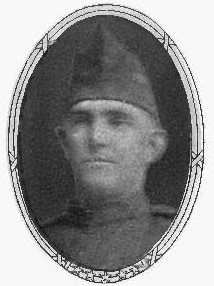Hero Bio:
Fred Lundgren was born in Mayfield, Sanpete County, Utah, July 6th, 1888. He remained there until he had reached the age of sixteen years. When he went to Idaho to take up farm work. A year later (1905) he moved to White Pine County, Nevada, which was his home from that time until he entered the service. He followed farming for the most part and did much riding, but he also gave some time to mining, and prior to leaving for the army, was engaged in hauling ore by team at Hamilton. On October 4th, 1917, he entered the service with a White Pine County contingent. He served in the 34th and 16th Battalions of the 166th Depot Brigade at Camp Lewis, Washington, until November 8th, then was transferred to Headquarters Company, 161st Infantry, 41st Division. The unit crossed to France in December, 1917, where it became a depot division for supplying troops to the combat divisions. Corporal Lundgren was transferred with a replacement to Headquarters Company, 11th Infantry, 5th Division, on August 30th, 1918.
On the 12th of September following, the 5th Division took part in the opening of the St. Mihiel drive, jumping-off at the village of Regnieville-en-Haye on the right wing. The action continued until the 16th and resulted in the complete wiping-out of the sector, with a loss to the Germans of 16,000 prisoners, 443 guns, and large stores of materials and supplies. Our losses were less than 7,000 casualties. After that battle the corporal wrote to his brother, under date of September 22d: “I have been up where I could hear the bullets singing ‘I want you now.’ Sleeping in a shell-hole isn’t as pleasant as it could be. The U. S. boys have sure got the Hun on the move now.”
On September 26th, the Meuse-Argonne offensive began. The 5th Division entered the line of October 14th near Romagne-sous-Montfaucon and Cunel. They drove northward, gradually lengthening their front, then turned eastward toward the Meuse. In the words of General Pershing, our troops “crossed the Meuse in a brilliant operation by the 5th Division, driving the enemy from the heights of Dun-sur-Meuse and forcing a general withdrawal from the strong position he (the enemy) had so long held on the hills, north of Verdun.” Again turning north, the 5th advanced with the Third Corps, clearing the enemy “from the wooded heights and driving him out into the swampy plain of the Woevre.” By the 10th of November, the day before the Armistice, the line was in the Bois de Remoiville. While fighting gallantly with his regiment, Corporal Lundgren was struck by a shell which killed him instantly. This happened about 2 ½ kilometers southwest of Remoiville.
Just a week before his death (November 3d) he wrote to his brother: “Just came out of another big battle * * * and it sure was a real one. This time was in a whole lot longer than the first time. * * * I am back of the front line quite a ways now, lying in my little hole on the side of the hill looking out over the old battlefield. * * * Once in awhile I hear a Hun airplane coming over, and a little artillery firing all the time, as we are sure keeping him on the run all the time. * * * We are the good old U. S. boys that never stop for anything.”
Those who survive the brave Nevada boy are his father, Charles Lundgren of Madeline, Lassen County, California; his brother, J. A. Lundgren, of Osceola, Nevada; and his sisters, Mrs. J. E. Childs, of Garfield, Utah; Mrs. P. G. Lund, 144 Milton Avenue, Salt Lake City, Utah, and Mrs. J. A. Burton, of Kenilworth, Utah.
Rank in Death:
Regiment, Brigade, Division in Death
Corporal Headquarters Company 11th Infantry 5th Division
